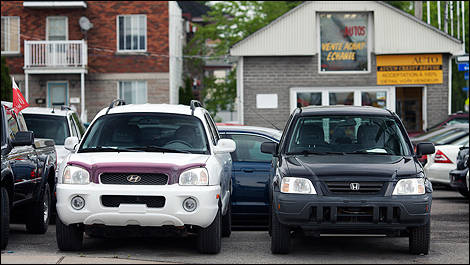I love window-shopping for used cars. Many of us at the office actually scrupulously enjoy sifting through online classified ads for cool, older cars like the Acura Integra, Volkswagen GTI, Dodge Omni GLH or Saab 9-3 Viggen.
What I enjoy the most is clicking from one picture to another trying to pick out clues that the car has been repainted or even involved in an accident.
Some are very obvious. The best examples or clues that a car’s been resprayed, at least in part, are when fender and door colors do not match. It is most obvious when the car is a light shade such as silver or beige. I can’t tell how often I’ve pointed out that an “original paint” silver Acura Integra was nothing less than 50 shades of grey, and not silver. Just look for shadows.
Obviously, a hood with a red underbelly while the remainder of the car is silver tells its own tale…
Another clue is fender gaps. If they’re not even then the car’s been hit, period. Nobody replaces a door for fun; the gap is uneven because the door or pillar has moved. Same goes for bumper-fender, trunk-lid and quarter-panel gaps. Cars built in the last 20 to 25 years were generally well aligned out of the box.
A further clue is overspray. Some body shops are especially lazy when it comes to fixing smashed cars. All that needs to be done is to open doors, hoods, boot lids and fuel-filler doors to closely inspect rubber seals and also look for paint ridges around the seals or paint flakes that should not be present.
Occasionally, the real slobs don’t even bother covering up the back box or the struts when painting. If they show signs of overspray, say thanks but no thanks.
About hits: Consider carefully checking out door hinges and latches. If there are signs of rubbing or scratches, the door is misaligned which is often a sign of some kind of impact. Same goes for a hood latch that requires an enormous amount of top pressure to catch. Again, unless damaged or thoroughly rusted, these latches should not be so bad.
Another trick is lifting the trunk’s carpeting. Most modern cars are lined with some form of insulation to prevent road noise. If this material is severely cracked or the floor is buckled, this car was once rear-ended. Also inspect the cardboard or plastic insert that sits atop the spare tire. If it is bent or cracked, same thing.
Looking under the hood can be very revealing, however, one needs to know what they are looking for. Essentially, harsh kinks, unusual bends and folds are typically not found under the bonnet of an accident-free car.
Another fun clue is license plate numbers. In most provinces, plates are issued in sequence. With a little time, one can get a clue as to when a plate was issued. This typically helps when a seller uses the old, “I’ve owned this for years, and have babied it from the beginning” line and you can tell that the plate is barely a few months old.
There are a number of other things to look for; however, nothing replaces a thorough inspection performed by a professional. Check out our Used Car Buying Guide for more details.
What I enjoy the most is clicking from one picture to another trying to pick out clues that the car has been repainted or even involved in an accident.
 |
| Photo: Sébastien D'Amour |
Some are very obvious. The best examples or clues that a car’s been resprayed, at least in part, are when fender and door colors do not match. It is most obvious when the car is a light shade such as silver or beige. I can’t tell how often I’ve pointed out that an “original paint” silver Acura Integra was nothing less than 50 shades of grey, and not silver. Just look for shadows.
Obviously, a hood with a red underbelly while the remainder of the car is silver tells its own tale…
Another clue is fender gaps. If they’re not even then the car’s been hit, period. Nobody replaces a door for fun; the gap is uneven because the door or pillar has moved. Same goes for bumper-fender, trunk-lid and quarter-panel gaps. Cars built in the last 20 to 25 years were generally well aligned out of the box.
A further clue is overspray. Some body shops are especially lazy when it comes to fixing smashed cars. All that needs to be done is to open doors, hoods, boot lids and fuel-filler doors to closely inspect rubber seals and also look for paint ridges around the seals or paint flakes that should not be present.
Occasionally, the real slobs don’t even bother covering up the back box or the struts when painting. If they show signs of overspray, say thanks but no thanks.
About hits: Consider carefully checking out door hinges and latches. If there are signs of rubbing or scratches, the door is misaligned which is often a sign of some kind of impact. Same goes for a hood latch that requires an enormous amount of top pressure to catch. Again, unless damaged or thoroughly rusted, these latches should not be so bad.
Another trick is lifting the trunk’s carpeting. Most modern cars are lined with some form of insulation to prevent road noise. If this material is severely cracked or the floor is buckled, this car was once rear-ended. Also inspect the cardboard or plastic insert that sits atop the spare tire. If it is bent or cracked, same thing.
Looking under the hood can be very revealing, however, one needs to know what they are looking for. Essentially, harsh kinks, unusual bends and folds are typically not found under the bonnet of an accident-free car.
Another fun clue is license plate numbers. In most provinces, plates are issued in sequence. With a little time, one can get a clue as to when a plate was issued. This typically helps when a seller uses the old, “I’ve owned this for years, and have babied it from the beginning” line and you can tell that the plate is barely a few months old.
There are a number of other things to look for; however, nothing replaces a thorough inspection performed by a professional. Check out our Used Car Buying Guide for more details.


